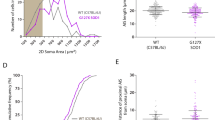Abstract
IN patients suffering from diseases of the lower motor neurone, grouping of muscle fibres of histochemical type 1 associated with a raised functional terminal innervation ratio has been demonstrated. This could be explained in either of two ways: (1) the neurones innervating type 2 muscle fibres are more susceptible to degeneration and when this occurs the denervated muscle fibres are re-innervated by collateral sprouts from nerve fibres previously innervating type 1 fibres. The type 2 fibres then take on the histochemical properties of type 1 fibres, which is in accordance with the demonstration2–4 that when a nerve previously serving a muscle containing predominantly type 1 fibres is transplanted into a muscle containing predominantly type 2 fibres, the histochemical characteristics of the latter become those of type 1 fibres. The mechanism by which this change comes about is uncertain, but it may be dependent on the frequency of passage of impulses along the nerve fibres5, a higher frequency favouring development of type 2 characteristics. The evidence against this explanation lies in the absence in most of our cases with type 1 grouping of any atrophic type 2 fibres. It is possible, however, that all the denervated fibres became re-innervated before they had time to atrophy. Further, where atrophic muscle fibres are present in primary disease of the lower motor neurone, in our experience (with human muscle) they are rarely predominantly type 2. (2) The re-innervating terminal sprouts, whether from axons of neurones previously serving muscle fibres of type 1 or 2, may be insufficiently mature to enable them to conduct every impulse reaching them from the parent axon. Thus the frequency of stimulation of the re-innervated muscle fibres would be substantially reduced. In these circumstances the type 2 muscle fibres, whether re-innervated by sprouts from axons previously serving type 1 or 2 fibres, would assume type 1 characteristics. Original type 1 fibres re-innervated in this way would, of course, retain their original histochemical characteristics irrespective of the type of muscle fibre previously—and still—innervated by the parent axon of the re-innervating sprout.
This is a preview of subscription content, access via your institution
Access options
Subscribe to this journal
Receive 51 print issues and online access
$199.00 per year
only $3.90 per issue
Buy this article
- Purchase on Springer Link
- Instant access to full article PDF
Prices may be subject to local taxes which are calculated during checkout
Similar content being viewed by others
References
Morris, C. J., J. Neurol. Neurosurg. Psychiat., 32, 440 (1969).
Dubowitz, V., and Newman, D. L., Nature, 214, 840 (1967).
Karpati, G., and Engel, W. K., Nature, 215, 1509 (1967).
Romanul, F. C. A., and Van der Meulen, J. P., Arch. Neurol., 17, 387 (1967).
Salmons, S., and Vrbova, G., J. Physiol., 201, 535 (1969).
Author information
Authors and Affiliations
Rights and permissions
About this article
Cite this article
MORRIS, C., WOOLF, A. Mechanism of Type 1 Muscle Fibre Grouping. Nature 226, 1061–1062 (1970). https://doi.org/10.1038/2261061a0
Received:
Revised:
Issue Date:
DOI: https://doi.org/10.1038/2261061a0
Comments
By submitting a comment you agree to abide by our Terms and Community Guidelines. If you find something abusive or that does not comply with our terms or guidelines please flag it as inappropriate.



